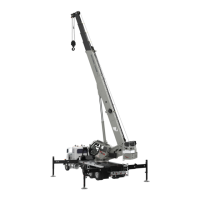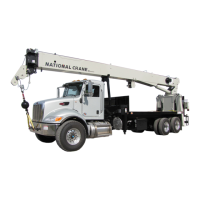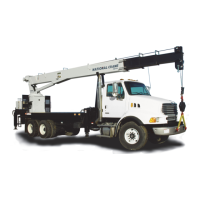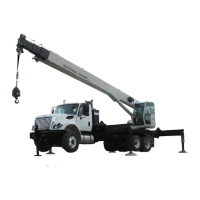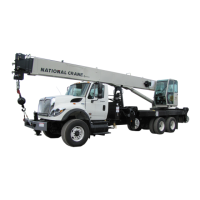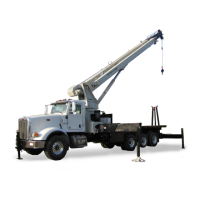2-34 Published 9-26-2018 Control # 646-02
SAFETY PRECAUTIONS NTC55 OPERATOR MANUAL
Sparks from the crane’s electrical system and/or engine
exhaust can cause an explosion. Do not operate this crane
in an area with flammable dust or vapors, unless good
ventilation has removed the hazard.
Carbon monoxide fumes from the engine exhaust can cause
suffocation in an enclosed area. Good ventilation is very
important when operating the crane.
Before actuating swing or any other crane function, sound
the horn and verify that all personnel are clear of rotating and
moving parts.
Never operate the crane when darkness, fog, or other
visibility restrictions make operation unsafe. Never operate a
crane in thunderstorms or high winds.
Always be aware of your working environment during
operation of the crane. Avoid contacting any part of the crane
with external objects.
Clear all personnel from the counterweight and
superstructure area before removing the counterweight.
Keep unauthorized personnel clear of the working area
during operation.
Only the crane operator shall occupy the crane when in
operation.
You must always be aware of everything around the crane
while lifting or traveling. If you are unable to clearly see in the
direction of motion, you must post a look out or signal person
before moving the crane or making a lift. Sound the horn to
warn personnel
Operate the equipment from the operator’s control station.
Do not reach in a window or door to operate any controls.
Operate the crane slowly and cautiously, looking carefully in
the direction of movement.
A good practice is to make a “dry run” without a load before
making the first lift. Become familiar with all factors peculiar
to the job site.
Ensure the rope is properly routed on the hook block and
boom nose and that all rope guards are in place.
Lifting
Use enough parts of line for all lifts and check all lines,
slings, and chains for correct attachment. To obtain
maximum lifting capacities, the hook block must be set up
with enough parts of line. Too few parts of line can result in
failure of the rope or hoist. No less than three wraps of rope
should remain on the hoist drum. When slings, ties, hooks,
etc., are used, make certain they are correctly positioned
and secured before raising or lowering the loads.
Be sure the rigging is adequate before lifting. Use tag lines
when possible to position and restrain loads. Personnel
using tag lines should be on the ground.
Be sure good rigging practices are being used. Refuse to
use any poorly maintained or damaged equipment. Never
wrap the hoist cable around a load.
If using a clam bucket, do not exceed 80% of the crane’s
capacity.
Make certain the boom tip is centered directly over the load
before lifting.
Ensure that all slings, ties, and hooks are correctly placed
and secured before raising or lowering the load.
Be sure the load is well secured and attached to the hook
with rigging of proper size and in good condition.
